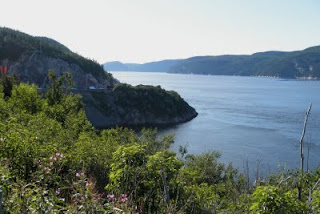
We crossed the border back into the U.S. at Stanstead, Quebec / Derby Line, Vermont today, the same place that we entered Canada just ten days ago.

As always, no matter how much we enjoyed our travels, it was good to get home!
While there's no doubt that the scenery of the Gaspe coastline and Lac St. Jean region is beautiful and dramatic, what made this trip interesting was not so much just the scenery, but the culture of Quebec province.
Of course, the language was a challenge to be dealt with; for someone like me who enjoys small talk with everyone in the supermarket line, it was strange to be rendered essentially hearing impaired and mute. (Speaking of supermarkets - it's always difficult to shop in an unfamiliar one, let alone when the aisle signs are in a foreign language --- although I did understand the sign for "bon-bons"). I will say that everyone that we encountered was very helpful and patient with our lack of French, and that the language barrier should not stand in the way of visiting a very pretty part of North America that is also within easy driving distance for most of us, $5.00+ per gallon gas notwithstanding!












































